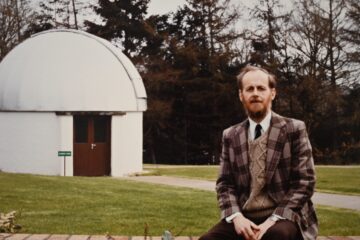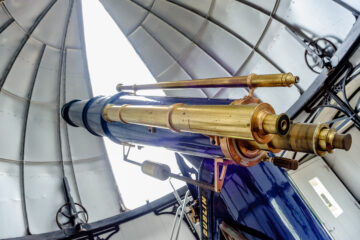Do you remember comet 67P/Churyumov-Gerasimenko? It was the target of the ESA’s Rosetta spacecraft, which visited and ultimately crash landed into the comet in its previous passage close to the Sun in 2014-2016. Rosetta made history as being the first spacecraft to ever orbit and land (with Philae) on a comet. Comet 67P is now on its way back towards the central Solar System after completing its orbit past Jupiter. Although it cannot be known for sure, it is highly likely that the spacecraft still lies of the comet’s surface.
This summer, AOP astronomers are observing comet 67P for their research and have obtained the first ground-based images of it since the Rosetta mission. The image shown below was taken using the FORS instrument of the ESO Very Large Telescope. The comet is still far away from the Sun, meaning it’s still faint, but will get brighter over the next few months. Here is a sneak-peek at the first image:
During the Rosetta mission, twenty-one instruments studied comet 67P and, in doing so, transformed not only our understanding of cometary science, but our perception of the formation of the Solar System, the origin of the materials which made the planets and, most importantly, how life started. Some argue that Rosetta is the most important mission to have ever flown. With 67P on its way back, let’s remind ourselves of some of the major discoveries made thanks to Rosetta.
1) Comets are not the origin of (most of) water on Earth:
Before the mission, one of the theories of the origin of water on our little blue planet is that it was bombarded with comets, which are basically dirty snowballs, in the early evolutionary stages of the Solar System. But as it turns out from Philae’s (Rosetta’s lander) findings, this was not the case. The ratio of deuterium (hydrogen with an extra neutron) to hydrogen (D/H in shorthand) is a key diagnostic tool in determining whether the water in Earth’s oceans has the same origin to Solar System bodies. The D/H measured on 67P is three times that found in terrestrial water, meaning that it is very unlikely that it came from comets. The D/H ratio measured from comet Halley also agrees with this finding. In fact, studies suggest that asteroids are most likely the source of the water on Earth, despite their low water abundance compared to comets. Earth must have had a very tough time during its formation.
2) Comets do not have magnetic fields:
Initially, scientists thought they had discovered the presence of a magnetic field on the comet and created a sound clip from the measured data to make it audible. 67P’s “magnetic song” can be heard here. However, the instruments on Philae did not detect the presence of a magnetic field. It was concluded that the sound is in fact the result of the interaction between the Solar wind and the comet’s atmosphere. One could say that the “magnetic song” is actually a duet between the comet and the Sun.
3) Molecular Oxygen is part of the comet:
The detection of molecular oxygen in the lower atmosphere of the comet was an unexpected find. In fact, it was the almost-constant O2/H2O ratio that surprised scientists the most, even as the amount of outgassing increased as the comet was warmed as it came closer to the Sun. Initially, it was thought that the O2 was created from the interaction of solar wind or UV radiation with the surface ices. If this were the case, the O2/H2O ratio would drop significantly as the comet approached the Sun due to the comet’s increased outgassing. However, the consistent O2/H2O ratio over the entire two year observation suggests that the O2 must have been incorporated in the comet ices during its formation. This tells us the oxygen is ‘primordial’ – meaning it was already present when the comet formed at the beginning of the Solar System 4.6 million years ago.
4) The comet is porous (lots of nothing):
To study the internal structure of the comet, radio waves were sent between Philae and Rosetta. This experiment revealed that the comet is very porous, i.e. around 75-85% of the comet is just empty space (a bit like a sponge, minus the squishy-ness). This suggests that the material that formed the comet gently clumped together and grew slowly over time, rather than crashing violently into each other and melting into solid bodies. Scientist have been debating theories regarding the formation of the Solar System for centuries and observations of extrasolar planetary systems in the more recent years agree with some more than others. Rosetta’s findings are helping us further understand the processes that occurred in formation and evolution of the Solar System.
5) Comets could have triggered life on Earth:
Rosetta collected over 35,000 dust grains from 67P and found that organic compounds, formed from carbon, hydrogen, nitrogen and oxygen, made up almost half of the comet’s mass. The large number of molecules found known to be the building blocks of life, including amino-acids, sugars and DNA’s nucleobases, is astonishing. This leads us to believe that the existence of life on Earth may be the result of the bombardment of comets when Earth was still young. If the organic molecules which triggered the emergence of life on Earth are of cometary origin, might they not also seed life on other planets in our galaxy?
Between Rosetta and Philae, our eyes have been opened to what the Solar System may have been like during its formation and has provided data that has and will yet lead to many discoveries. The AOP astronomers are hoping to use their new data and the findings of Rosetta to better understand comet 67P.
Looking to the future, the ESA will be launching a new mission, Comet Interceptor, in 2029. Its aim is to perform a flyby of a yet-undetermined comet that is even more pristine than 67P. The ideal target of the mission is an interstellar comet which is making its first ever approach to the Sun or a long-period comet. To read more about the difference between long-period, short-period (like 67P) and interstellar comets, see here. For now, keep your eyes and ears pealed for more news about Comet Interceptor!




0 Comments